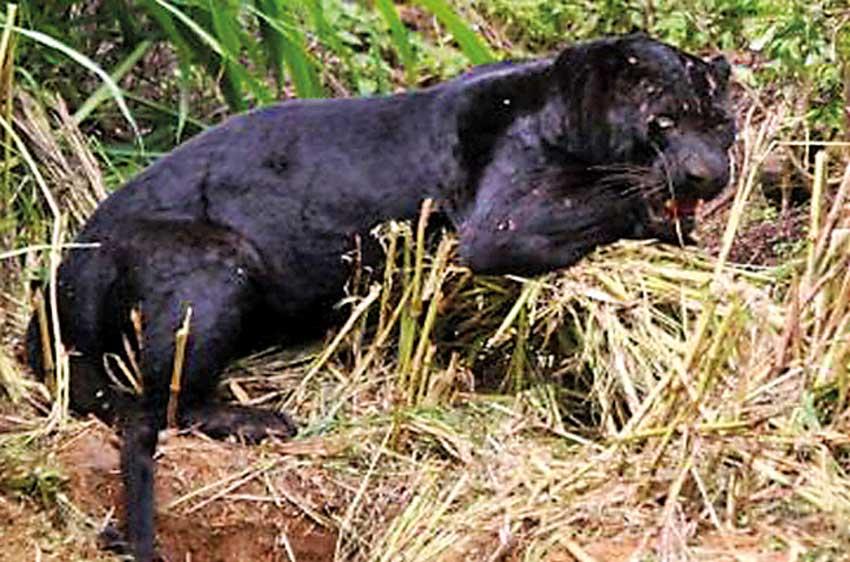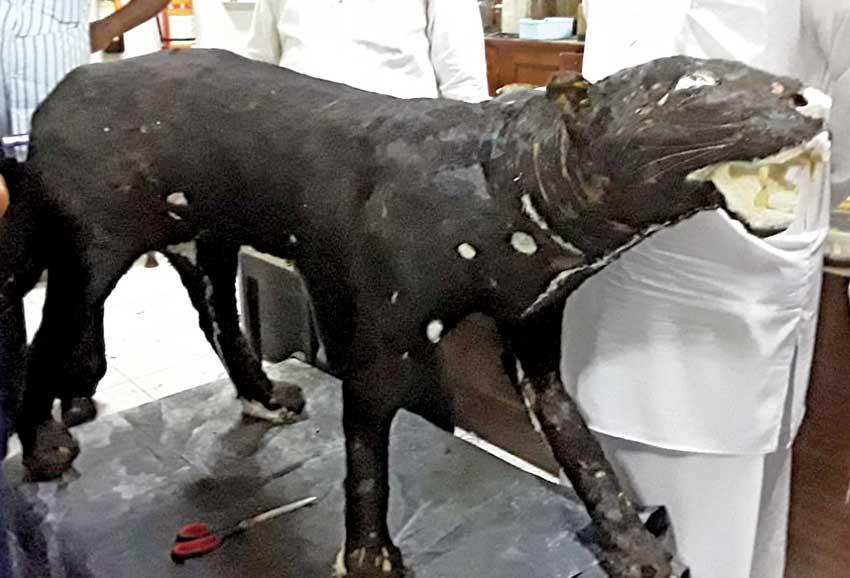Reply To:
Name - Reply Comment
Before

After

Photo of the black leopard circulating on social media. According to the Colombo National Museum preservation work is not yet complete
Black leopard’s carcass was brought on July 13
Skin conservation done within 12 hours of an animal’s death
Carcasses conserved depending on future purposes
 The Department of National Museums came under heavy scrutiny after photos of the black leopard’s carcass went viral on social media. The leaked photos were received with much fury as members of the wildlife loving community had already expressed their disappointment over the black leopard’s death. But this is the incomplete picture. At a moderate space dedicated to the Zoology Division at the Colombo National Museum complex, the black leopard’s carcass is still undergoing preservation work.
The Department of National Museums came under heavy scrutiny after photos of the black leopard’s carcass went viral on social media. The leaked photos were received with much fury as members of the wildlife loving community had already expressed their disappointment over the black leopard’s death. But this is the incomplete picture. At a moderate space dedicated to the Zoology Division at the Colombo National Museum complex, the black leopard’s carcass is still undergoing preservation work.
Functions of the Zoology division
Replicas of stuffed animals from deer to Indian bulls, sambar deer, Brahminy Kites, peacocks, reptiles, snakes,
|
A giant tortoise undergoing preservation |
|
Inside the Zoology Division at the Colombo National Museum |
species of the cat family welcome you at this Division. It was established parallel to the opening of the museum back in 1877 and acts as the focal point of the National Faunal Repository in Sri Lanka. The Division has had specimens that have been conserved even before this period. “We conserve specimen so that they will remain for many years to come,” said Lankani Somarathna, Assistant Director - Zoology. “We conserve a carcass depending on its future purpose. So we either conserve the skin and skeleton (dry conservation also known as taxidermy) or we dip the carcass in an alcohol substance (wet conservation). In most instances we conserve the skin than the skeleton. If it’s a bird we maintain the shape and conserve the skin. But there have been instances when we conserved the skeleton for example in the case of the blue whale which was over 125 years old,”
explained Somarathna.
The division includes over 23,000 vertebrate wet specimens apart from an extensive collection of invertebrates including mollusks, polychetes and other invertebrate specimens.
Technical procedures
There are several ways in which carcasses are obtained. Either people hand them over to the museum or museum officials obtain them from the Wildlife Department or at the field. Carcasses are also obtained via court orders. “If we are going to do skin conservation then we have to obtain the carcass within 12 hours of an animal’s death,” added Somarathna. “The skin has to be cleaned and preservatives need to be added. We add chemicals to fix the skin, so that it won’t be damaged by pests or get rotten in a short span of time. When a carcass is brought in we take the actual measurements of the animal and maintain a report for every animal. According to measurements we make a dummy out of wires, fiber and plaster of Paris. Measurements differ from animal to animal. Once the dummy is done we cover it with the original skin that has been preserved. But if it’s a bird a dummy isn’t that necessary. So we take the skin and stuff them with cotton wool. For a snake we take a wire mesh and fill with coir. But we always take the original skull because we cannot make the head as it is. We sometimes preserve internal organs such as the heart, lungs. If the carcass is over 12 hours old we usually preserve the skeleton.”
Special circumstances
|
Replicas of stuffed animals |
|
A preserved leopard’s carcass |
The stuffed tusker popularly known as the Raja Atha, currently on display at the Sri Dalada Maligawa is one of the outstanding works carried out by the staff of this division. “To date we maintain it and conduct conservation activities,” she added. “We also guarantee that the Blue Whale’s skeleton will remain for another 100 years as it is. Back in 2013 we launched an osteology gallery for those interested to study this field. Some other specimen on display include Heiyanthuduwa Raja and the she-elephant Lechchami. Several species of the cat family including the leopard are also on display,” said Somarathna.
Further improvements
Taxidermy is an art and therefore it’s techniques evolve. “The knowledge that is being passed on has been in existence ever since colonial times, but we update it to suit modern trends,” Somarathna explained. “These depend on exhibition methods and are mostly inspired by practical experiences. We have already conserved the blue whale, but we need an updated technology. Through taxidermy we preserve an animal and display it in an original environment for people to learn. So we need to refurbish galleries accordingly,” she said.
According to Encyclopedia Britannica, taxidermy maybe traced to the ancient custom of preserving trophies of the hunt, but the principle motive of its development into an art was the growth of interest, especially from the time of Enlightenment and the consequences of appearance of both private collections and exhibits in public museums. By the early 18th Century, chemical means of preserving skins, hair and feathers from decay and insects made possible the first crude attempts to recreate the experience of live animals by stuffing the sewed-up skins with hay or straw. This inspired rapid improvements of preparing skins and novel techniques such as mounting followed. American naturalist and Explorer Carl. E. Akeley is credited for introducing the taxidermic method of mounting.
Mounting created a trend towards realistic display with animals in positions suggesting great activity observed in their natural habitats with real or artificial vegetation, painted backgrounds and lifelike scenes. In the 19th century, taxidermy was firmly established as a museum art in the work of such commercial houses as Maison Verreaux in Paris, founded by a naturalist and explorer which furnished great numbers of exhibits to museums.
“When we received news of the black leopard’s death we informed the Buddhasasana Ministry Secretary who now serves as the Secretary of the Wildlife Ministry because we didn’t have a carcass of a black leopard,” Somarathna said. “There’s one carcass of a black leopard preserved at the Giritale Museum which comes under the purview of the Wildlife Department. But the national repository didn’t have one. Thereafter he had discussed with Wildlife Department Director General who had agreed to present it to the museum. But it couldn’t be obtained unless via a court order. Once the court approved we brought the carcass from the Peradeniya University on July 13. Although it was days after the leopard’s death there wasn’t much of an issue in conserving the skin since it was kept in a deep freezer. But during a postmortem a carcass isn’t dissected in the same way it’s being done during a taxidermy. With all those challenges we had to conserve the skin. Recently the subject minister paid a visit to observe the conservation process and during his visit someone has taken a photo and released to social media. But it’s still in the process of being preserved,” said Somarathna.
Responding to claims about the odd shape of the preserved carcass especially in its skull area, Somarathna said that a fiber model had been used instead of the animal’s actual skull. “This is because we are conserving the animal’s skin as well as the skeleton,” she said.
Upon close observation the Daily Mirror witnessed a better version of the carcass, contrary to the photo circulating on social media with its spots, claws and jaws in tact.

A legacy untold
Although leopards were under the spotlight during recent times, it had been a much celebrated animal of yesteryear. Prof. Nimal De Silva in his book titled ‘Flags and Flag traditions of Sri Lanka’ sheds light on this lesser known aspect of leopards. According to him a flag is an art that goes back to the earliest days of human civilization throughout the world. Sinhalese being one of the earliest civilizations with a documented history that goes back to over 2500 years have also created and used flags.
Wellassa Dissawa flag
The flag of the Wellassa Dissawa displays the leopard as its main symbol. In fact there are three flags depicting leopard. The popularly identified Wellassa Dissawa flag is a horizontal rectangular flag of a simple design with two leopards in confronting position and the red line border along the upper edge is missing. But the flag found from the Malwatta Vihara, Kandy depicts two leopards in rampant position while the background is filled with lotus flowers.
Ihala and Pahala Dolospattu of Hath Korale
The Viyagra Maha Kodiya found at the Dalada Maligawa is a rectangular horizontal flag depicting a tiger, drawn with a body covered in dots instead of lines and a stylised face carrying a flag in one hand. This could be because local artists hadn’t seen a tiger but only leopards.
A stretched drawing of a leopard was also found in the kotiya bendi kodiya (see pics).